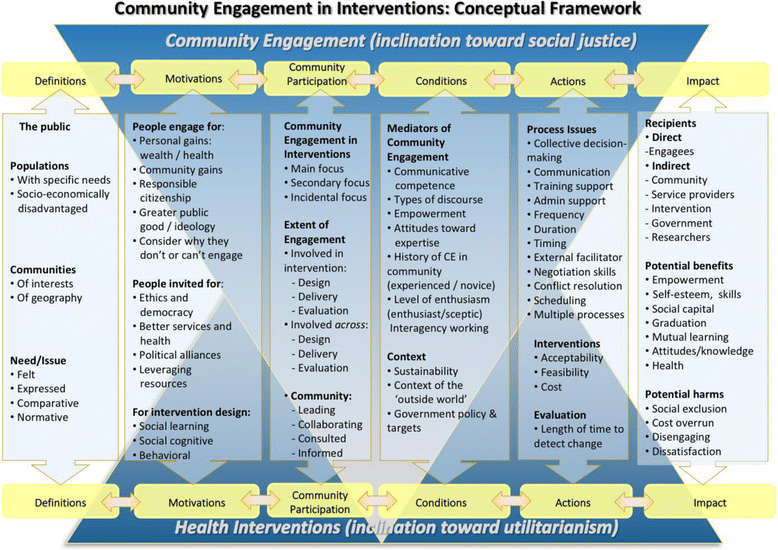Narratives of community engagement: a systematic review-derived conceptual framework for public health interventions
- PMID: 29228932
- PMCID: PMC5725895
- DOI: 10.1186/s12889-017-4958-4
Narratives of community engagement: a systematic review-derived conceptual framework for public health interventions
Abstract
Background: Government policy increasingly supports engaging communities to promote health. It is critical to consider whether such strategies are effective, for whom, and under what circumstances. However, 'community engagement' is defined in diverse ways and employed for different reasons. Considering the theory and context we developed a conceptual framework which informs understanding about what makes an effective (or ineffective) community engagement intervention.
Methods: We conducted a systematic review of community engagement in public health interventions using: stakeholder involvement; searching, screening, appraisal and coding of research literature; and iterative thematic syntheses and meta-analysis. A conceptual framework of community engagement was refined, following interactions between the framework and each review stage.
Results: From 335 included reports, three products emerged: (1) two strong theoretical 'meta-narratives': one, concerning the theory and practice of empowerment/engagement as an independent objective; and a more utilitarian perspective optimally configuring health services to achieve defined outcomes. These informed (2) models that were operationalized in subsequent meta-analysis. Both refined (3) the final conceptual framework. This identified multiple dimensions by which community engagement interventions may differ. Diverse combinations of intervention purpose, theory and implementation were noted, including: ways of defining communities and health needs; initial motivations for community engagement; types of participation; conditions and actions necessary for engagement; and potential issues influencing impact. Some dimensions consistently co-occurred, leading to three overarching models of effective engagement which either: utilised peer-led delivery; employed varying degrees of collaboration between communities and health services; or built on empowerment philosophies.
Conclusions: Our conceptual framework and models are useful tools for considering appropriate and effective approaches to community engagement. These should be tested and adapted to facilitate intervention design and evaluation. Using this framework may disentangle the relative effectiveness of different models of community engagement, promoting effective, sustainable and appropriate initiatives.
Keywords: Community engagement; Conceptual framework; Health promotion; Public health; Systematic review.
Conflict of interest statement
Authors’ information
Co-authors hold multiple degrees in different disciplines that span sociology, psychology, history, music, midwifery, nursing, economics, and research methodology.
Ethics approval and consent to participate
This project was approved by our Faculty Research Ethics board; copies of the ethics application are available from the report authors. The project complies with the Economic and Social Research Council (ESRC) Research Ethics Framework.
Consent for publication
Not applicable.
Competing interests
The authors declare that they have no competing interests.
Publisher’s Note
Springer Nature remains neutral with regard to jurisdictional claims in published maps and institutional affiliations.
Figures
References
-
- National Institute for Health and Clinical Excellence . NICE public health guidance 9: community engagement to improve health. London: NICE; 2008.
-
- Department of Health . Commissioning and system management - PPE. Real involvement: working with people to improve health services. London: Department of Health; 2008.
-
- O'Mara-Eves A, Brunton G, McDaid D, Oliver S, Kavanagh J, Jamal F, et al. Community engagement to reduce inequalities in health: a systematic review, meta-analysis and economic analysis. Public Health Res. 2013;1(4):548. - PubMed
Publication types
MeSH terms
Grants and funding
LinkOut - more resources
Full Text Sources
Other Literature Sources




